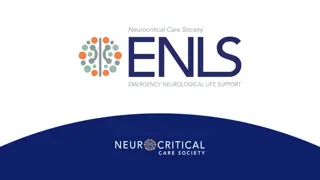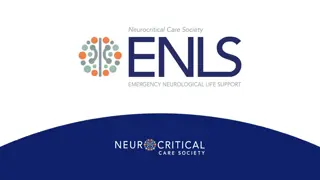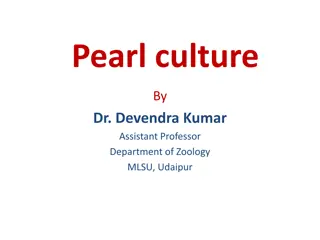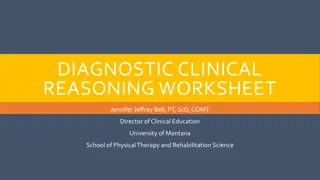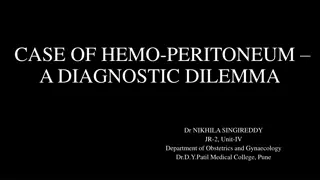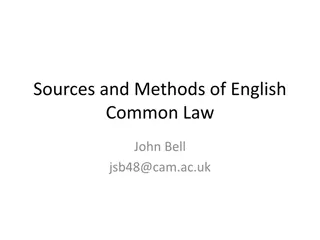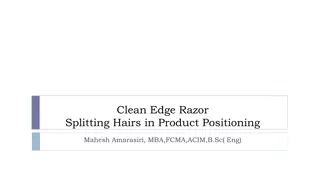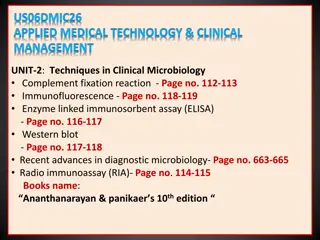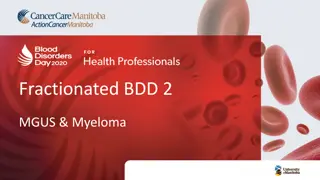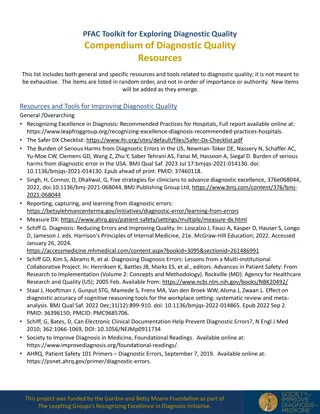Diagnostic Pearls: Occam's Razor vs. Hickam's Dictum in Clinical Practice
Discussing the fundamental principles of Occam's Razor and Hickam's Dictum in medical diagnosis, this content highlights the importance of considering simpler explanations before complex ones (Occam's Razor) and the possibility of multiple diseases coexisting in a patient (Hickam's Dictum). Through case studies and philosophical insights, clinicians are reminded to balance diagnostic parsimony with the recognition of diverse presentations in patients.
Download Presentation

Please find below an Image/Link to download the presentation.
The content on the website is provided AS IS for your information and personal use only. It may not be sold, licensed, or shared on other websites without obtaining consent from the author. Download presentation by click this link. If you encounter any issues during the download, it is possible that the publisher has removed the file from their server.
E N D
Presentation Transcript
Watch this ! https://www.youtube.com/watch?v=sO6EE1xTXmw
What diagnosis do you think of? Discuss the differential diagnosis for each case. A 19 year old woman presents with lethargy, rash, jaundice and a palpable liver. She was given amoxicillin for a sore throat 5 days ago. A 21 year old woman presents with lethargy, nausea and jaundice. She has recently travelled to the Middle East and engaged in casual sex there.
Common things are common When you hear hoof beats, think of horses not zebras". And definitely not Kudus!
Occams razor Both these cases represent the philosophy of William of Occam a Franciscan friar who stated that entities should not be multiplied beyond necessity . i.e. diagnostic parsimony Suppose there exist two explanations for an occurrence. In this case the simpler one is usually better. Another way of saying it is that the more assumptions you have to make, the more unlikely an explanation. The clinician should seek a single diagnosis rather than diagnosing two or more unrelated ones. This is the first diagnostic pearl of wisdom.
Another case A 50 year-old woman presents with weight loss, lethargy, thirst, and polyuria. She feels generally unwell but is sleeping OK. no night sweats. On examination, she has a tachycardia of 110 bpm SR, looks thin, and has a tremor. She is not dehydrated but there is evidence of recent weight loss and she looks pale. This patient had both new thyrotoxicosis and new diabetes mellitus (presenting more dramatically because of the thyrotoxicosis). Relates to the next diagnostic pearl of wisdom.
Hickams dictum John Hickam - Chairman of Medicine at Indiana University graduated from Harvard in 1940 and stated that multiple symptoms and signs may be due to more than one disease second diagnostic pearl of wisdom patients can have as many diseases as they damn well please . This is the medical counter-argument to Occam s razor. It is often statistically more likely that a patient has several common diseases, rather than having a single rarer disease which explains their myriad symptoms.
Hickams dictum An example of this is Saint s triad of hiatus hernia, cholelithiasis and diverticular disease 3 separate entities that have no pathophysiological relationship. Saint emphasized the importance of considering the possibility of multiple separate diseases in a patient whenever his/ her history and the results of the physical examination were atypical of any single condition for older patients, the scales may tip in favour of Hickam.
How do doctors diagnose. Medical students and hospital doctors still use the inductive (classical) method based on a comprehensive history (HPC), full systematic enquiry, PMH and DH, FH and SH and physical examination. A diagnosis is sought out at all costs . This method is systematic, indiscriminative and expensive in time and resources. Furthermore the all you can scan body investogram and the battery of bloods provides a rat s maze of blind alleys to pursue. Think autoantibody screening !!
Examples of this 70 year old lady presents at ED with chest pain ECG and troponin test negative. SE notes heartburn and use of ranitidine. Diagnosed reflux. But she has had heartburn for years and this does not feel like it to her sees GP after. GP does not diagnose a condition but thinks likely to be anxiety related. Another man has respiratory problems and at OPA is diagnosed as COPD. Spirometry shows mild obstruction treated with a LAMA - and told to see GP for follow-up of his ANA titre of 1/160
What diagnosis comes to mind? A 47 yr old man consults because he has had diarrhoea for the past 10 days with occasional cramping abdominal pain and feeling off colour. 3 weeks ago he travelled for an academic convention. He has not lost weight or noticed blood or mucus in his stools. He has taken loperamide for the past few days without much benefit. Further questioning reveals fever, aches, and night sweats.
Possible diagnosis Where did he travel: Bangkok Was there any risky behaviour he thinks so !! Examination reveals swollen lymph nodes. Is this something less common Could this be something really important Is early diagnosis needed ?
Karl Popper falsification theory Popper (Austrian philosopher) stated that if you suppose all swans are white, you will not find any swans but white swans One should, in fact, be searching for black swans Called the falsification principle So formulate testable hypotheses remind ourselves to consider alternatives to our initial diagnosis. What can I not afford to miss ?
Another example A 50 year old man presents with low back pain despite no trauma and it is advised that it is mechanical and to take otc analgesia. (no examination is done) He then presents later, and due to his job as a lecturer during a busy exam period, is advised of a link to stress there is no loss of function but the pain is getting worse, especially at night. He presents to ED with worsening pain, urinary problems and night sweats he is diagnosed with lymphoma (near his lumbar spine)
Poppers confirmation bias. Doctors, and in particular GP s, should always bear in mind the fallibility of their assumptions. Confirmation bias is a tendency for people to favour information that confirms their preconceptions or hypotheses regardless of whether the information is true. As a result, people gather evidence and recall information from memory selectively, and interpret it in a biased way.
The hypothetico-deductive model In GP, we approach consultations differently. Doctors begin to formulate diagnostic possibilities very early on in the consultation these hypotheses are based on cues (verbal and non-verbal), obtained from the patient and from their medical record. As the consultation develops, these hypotheses are ranked and further information is gathered (by history and exam) to confirm or refute them. New ideas may develop and hypotheses may be revised if the above reveals no support.
Iterative diagnosis Sometimes called the iterative model meaning recurrently testing the hypotheses. Process is simultaneous, intuitive and analytical - clinical reasoning is usually invisible and so inherent to the clinician, he is scarcely be aware of using it. Clinicians use many such decisional shortcuts (heuristics) in clinical reasoning this is not a fault they are typically correct and allow them to arrive at a working diagnosis with the minimum of delay. This can avoid excessive testing and anxiety. Exhaustive data collection without hypotheses usually does not improve diagnostic accuracy and may make it worse.
When is iterative diagnosis used GPs will recognise that they formulate one or more presumptive hypothesis when the patients starts to speak The acute onset of vertigo when rolling over in bed The GP listens to history through the filter of the initial hypothesis Does the vertigo come on with head movements and become less severe over a minute or two ? The GP s examination will be directed to supporting or refuting a hypothesis Is the Hallpike test positive ?
What are you thinking? A women presents, with headaches, and this time with her husband who is concerned. The headaches are getting worse and she seems more vague at times. She was seen 4 days ago with sudden onset of severe headache developing over about 3-4 hours. There was no visual disturbance and neurological examination was entirely normal. She was given dihydrocodeine to take with otc paracetamol.
Iterative diagnosis It is an essential component of medical exercise Involves rapid, simultaneous generating and testing of hypotheses. It is usually fast, efficient and accurate. A GP will formulate one or more presumptive hypotheses as the patient walks into the room and starts talking this will direct the history. Examination will usually be directed towards supporting or refuting a hypothesis. Sometimes intuition will apply a brake to the analytical reasoning something doesn t fit
For example: A 55 year old road worker hobbles in wearing a slipper on his foot saying his big toe is agony He has had this once before and lasted about 2 weeks. He is no medication other than inhalers. He has taken ibuprofen for 5 days with no benefit Examination reveals a very swollen foot generally with tenderness and heat over the MTP joint and dorsum of foot. He seems a bit clammy and his temp is 38.3C You notice a possible puncture wound on the sole.
Stages in reaching a diagnosis Iterative diagnosis can otherwise be described as diagnostic reasoning Can be split into a 3 stage model: Initiation of diagnostic hypotheses Refinement of the diagnostic hypotheses Defining the final diagnosis Not all stages are necessary. For instance a spot diagnosis of acne at the initiation stage may miss out the refinement stage.
Initiation stage Spot diagnosis is almost instantaneous and used in about 20% of cases. Often skin diagnoses such as eczema or moles. Self diagnosis is expressed by about 20% of patients can be accurate in recurrent UTIs in women (84% concordance) or often inaccurate such as I have a chest infection . Presenting complaint such as I have a headache is used most often by GPs over 60% of cases. Pattern recognition trigger is least common such as thirst, weight loss and feeling unwell in a teenager.
Refinement stage Restricted rule outs knowing the commonest cause of the presenting problem and ruling out serious diagnosis ( headache, TTH, SAH and TA). Stepwise refinement based on anatomy or pathology. Such as wrist pain is located to radial side and linked to the thumb. Probabilistic reasoning specific (but imperfect) use of symptoms, signs or diagnostic tests to rule in or rule out a diagnosis. Such as urine dipstick in UTI. Pattern recognition fit sx and signs are compared to previous patterns/ cases and a disease is recognised when the pattern fits. commonly used. in acute MI Clinical prediction rule is a formal version of pattern recognition such as ABCD for stroke risk or Ottawa ankle rules.
Final definition stage Known diagnosis in nearly 50% cases, a sufficient level of certainty is present to start appropriate treatment . Such as viral URTI or warts. Ordering further tests a standard test can rule in/ out the disease, such as a MSU for UTI. Or a colonoscopy for red flags of bowel cancer. Test of treatment when the diagnosis is uncertain, the response to treatment is often used to refute or confirm it. Such as inhalers for nocturnal cough. Test of time. A wait and see strategy allows the diagnosis to become more obvious such as a patient with abdo pain, D&V with no red flags who is diagnosed as having viral gastroenteritis when better after 1-2 weeks. No label applied where no diagnostic label could be assigned to the patient, presentations were often vague and did not fit a recognisable pattern.
Coffee break Welcome back Now watch this. https://www.youtube.com/watch?v=FmqSkIc7FO8 We are going to discuss how diagnoses may be wrong and how errors can occur
How does diagnosis go wrong In groups of 6, try to think of a case where a diagnosis was missed or delayed. What factors played a part in this What key decisions were made that resulted in an adverse outcome. What occurred to enable the diagnosis to be made.
How does diagnosis go wrong ? When errors in diagnosis occur, they are rarely due to a lack of knowledge or carelessness. No doubt, some errors are as a consequence of poor data gathering But critical data is often missed simply because the clinician was not thinking of the correct diagnosis. Although clinicians gather less data as they gain experience, this does not seem to have a negative effect on diagnostic accuracy.
Cognitive errors When diagnoses are missed, they are often due to one or more of a set of predictable cognitive errors. Cognitive bias is a predictable error of judgment due to a reliance on heuristics (rule of thumb) Clinicians use decisional shortcuts but reliance on methods such as process of elimination and trial and error can also lead to diagnostic errors.
Real case chest pain man An example of how a diagnosis can go wrong is attributing a set of symptoms to an easier diagnosis. A 52 year old diabetic man presents with an episode of central chest pain yesterday after eating pizza excessive burping which helped the pain. Chest pain is now resolved but wife said he needed to see the GP. Examination on the day is entirely normal. He is not that concerned and thinks it was due to heartburn. He has used otc antacids in the past and is happy to take omeprazole. 2 days later, he has a STEMI (and survives)
Confirmation bias Confirmation bias gathering information that will confirm rather than refute the diagnosis. Confirmation bias is a tendency for people to favor information that confirms their preconceptions or hypotheses, regardless of whether the information is true As a result, people gather evidence and recall information from memory selectively, and interpret it in a biased way. Think back to Popper s swans Don t ignore that which doesn t fit
Confirmation bias (2) A 65 year old lady presents with a headache and visual disturbance. The headache is unilateral and throbbing but improved with paracetamol. The headache makes her feel nauseous and wants to lie down. The visual disturbance, affecting her left side, has resolved today but the headache is still present. Has she had migraine before yes, but not for a long time Under a lot of stress. Pt just wants medication to make it better.
Confirmatory bias Confirmatory bias is the tendency to look for, notice, and remember information that fits with our pre-existing expectations. Similarly, information that contradicts those expectations may be ignored or dismissed as unimportant. In taking medical histories, doctors often ask questions that solicit information confirming early judgments. Even worse, they may stop asking questions because they reach an early conclusion, thus failing to unearth key data. More generally, the interpretation of information obtained towards the end of a medical work-up might be biased by earlier judgments.
Base rate neglect A phenomenon of how doctors can sometimes jump to inappropriate conclusions, with significant consequences. This can be linked to inappropriate confirmation - selective use of a minor abnormality to confirm an incorrect diagnosis. It is a well established concept in cognitive science, confirmed through extensive research. Mistakenly judging a situation without taking into account all the data.
Example A 62 year old lady comes in with fatigue and lethargy she is not sleeping well and has stress in the family. She thinks she needs blood tests you oblige TSH comes back at 9.8 (with normal T4) and all other blood tests are normal - you start her on levothyroxine. At 50mcg/ day 4 weeks later she presents with SOB and diagnosis confirms fast AF. She is hospitalised. The thyroxine is reduced to 25mcg/ daily She is now on a BB and feel even more tired ! 3 months later, the thyroxine is stopped and she is started on sertraline and begins to feel better.
Representative heuristic Base rate neglect is linked to representative bias which is giving too much weight to one piece of information and not being aware of the base rate of occurrence of a particular condition. A patient with a stroke scenario (dizziness and abnormal arm sensation)was less likely to be diagnosed if he had recently lost his job and smelled of alcohol. By the same token, if a disease is extremely rare, it may still be unlikely to be the correct diagnosis even if a patient has the signs and symptoms of that disease.
Availability bias Relating the case to an easily recalled example. This can sometimes be due to anchoring sticking to an initial diagnosis despite disconfirming evidence. This can be avoided by specifically going after signs and symptoms that would be inconsistent with the diagnosis, thus suggesting alternatives. The patient presenting with vertigo is specifically asked and tested for facial weakness. A child with acute otitis media is checked for mastoid tenderness.
Availability bias example A 44 yr old gentleman with chronic cough for 4 weeks is diagnosed with LPR after attending a recent ENT talk explaining that this is common and often treated inadequately. The patient (non-smoker) has a long h/o heartburn often treated with otc antacids so you start a PPI and review in 3 months. (chest is clear) He re-presents 1 month later, as he is no better, to another doctor who ascertains he is a paint sprayer and the cough is worse at night. Provisionally diagnosed as asthma and the condition improves.
Availability heuristic When we use the availability heuristic, we place particular weight on examples of things that come to mind easily, perhaps because they are easily remembered or recently encountered. In general, this guides us in the right direction, as things that come to mind easily are likely to be common, but it may also mislead. A doctor diagnoses chronic appendicitis because in a patient with non specific abdominal pain because he has had it himself recently. To avoid falling prey to the availability heuristic, doctors should try to be aware of all the diverse factors that influence a decision or diagnosis. They should ask if their decision is influenced by any salient pieces of information and, if so, whether these pieces of information are truly representative or simply reflect recent or otherwise particularly memorable experiences. Knowing whether information is truly relevant, rather than simply easily available, is the key.
Premature closure Arriving at a conclusion before gathering the critical data and not revisiting it. This is the dominant cause of diagnostic errors This could be avoided by reconsidering dissonant facts re-examine facts that don t quite fit. An example is diagnosing intermittent claudication in a non-smoker with exertional leg pains when further questioning would have resulted in a diagnosis of lumbar stenosis.
Premature closure example A 70 year old retired teacher with recurrent UTIs is started on low dose nitrofurantoin prophylactically. 1 year later, routine LFTs show a ALT of 54 attributed to fatty liver, being overweight. 3 months later, she presents with a widespread rash on her legs. Routine tests show an ALT of 161 and the rash is later diagnosed as a vasculitis after referral to hospital The nitrofurantoin is stopped and the liver enzymes return to normal. A claim is settled !
Premature closure case 1. MPS case (2016) 28 week pregnant lady (primip) asks for HV acutely unwell. Short h/o nausea and headache, as well as swollen ankles. The antenatal record showed weight gain of 25kg and the BP was mildly elevated . No record of urinalysis The patient was prescribed gaviscon and a diuretic and told to rest. Later that day, she had loss of vision followed by a grand mal seizure. She went to hospital by ambulance for emerg CS and baby was born with CP. Diagnosis was pre-eclampsia. Expert opinion was critical of no urinalysis or referral to hospital.
Premature closure case 2. MPS case (2015) 60 yr old HGV driver overweight and smoker walking limited by calf pain. Increasing pain right foot/ calf presented to ED and DVT excluded. Advised to see GP for circulation problems . Increasing pain at rest for next 2 nights foot felt cold and numb. Had to get up and walk around to relieve the pain. The GP the following day noted a cool, pale right foot and organised non-urgent Doppler assessment. And prescribed quinine. He then attended ED a few days later, following advice from GP over the phone, who noted weak pulses and diagnosed arterial insufficiency. Advised to attend doppler next week as planned.
Premature closure case 2 (cont) The patient attended Doppler exam the following week with the operator noting an acute painful, swollen calf with no result available due to pain. The patient was seen the next day by the same GP, referred to SDU the following day and admitted from there. Angiogram showed SFA thrombus. Embolectomy unsuccessful so proceeded to bypass but leg was not viable resulting in AKA. Resulting in phantom limb pain and loss of daily activities. MPS could not defend the claim due to lack of diagnosis of acute critical ischaemia and lack of urgency of referral.
Bandwagon effect Often a product of premature closure in choosing what other doctors choose . A young man sees doctor A with chest pain and cough, feels SOB and diagnosed with a chest infection. Started on amoxicillin but no better after 2 days. Sees doctor B who changes the antibiotic to doxycycline Sees doctor C the next day as more SOB and cough getting worse O2 sats 96% and p = 92bpm. Diagnosed CAP and sent for CXR that day Collapse at hospital and admitted via ED diagnosed P.E


